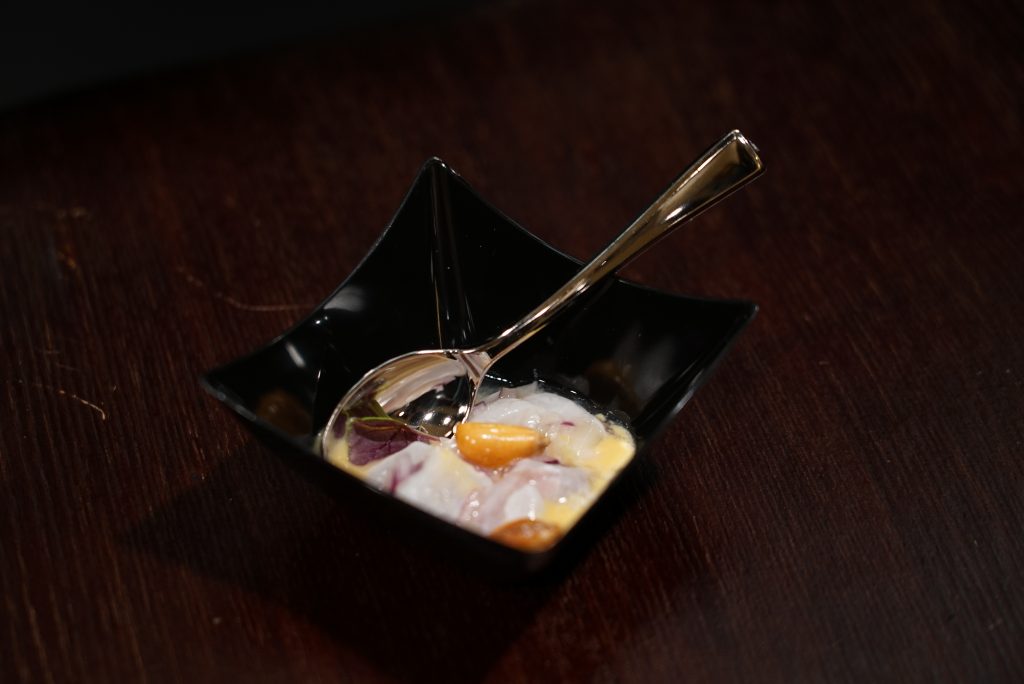This post is also available in: Español (Spanish)
These days we’re stuck at home are perfect for taking the opportunity to do activities that we weren’t doing before, either because we didn’t have time or didn’t think we’d be able to do them. One such activity – and one that we’d say is also the most successful – is definitely cooking. It’s a perfect way to entertain yourself, pass the time, learn about new techniques and flavours, and also to enjoy a nice dish, whether alone or as a family.
Taking this into account, at Taller, we challenge you to go one step further and try your hand at home-made haute cuisine by adapting some of our recipes. It’s always nice to give yourself a treat, and even more so during lockdown! However, we’re aware that going food shopping has become a trickier task at the moment, so, in addition to explaining the original dish, we’ll suggest some alternative ingredients so you can adapt our recipes using things that are easier to find at home.
Croaker ceviche

The first recipe we have for you to give a whirl is our croaker ceviche with tamarillo. In the original recipe, we use 100 grams of croaker, 1/4 red onion, one celery stalk, some coriander leaves, two limes and a 5- to 10-gram piece of ginger.
First, dice the fish and leave in the fridge in a bowl with an ice cube and salt for around 5 to 10 minutes. Meanwhile, chop the celery, coriander, onion and ginger into 3-mm cubes. Finally, mix everything, squeeze the juice from the limes over the mixture and leave it to rest for a minute before serving in a bowl.
If you’d like to adapt this recipe using ingredients you have at home or that are easier to find, here are some tips:
- The croaker can be substituted with other white fish (sea bass, seabream, perch, etc.), oily fish such as red mullet or even boiled octopus or prawns.
- If you don’t have celery, you can leave it out and just use red onion and coriander.
Purple corn crepe with roast suckling pig

In addition to being really tasty, this recipe is a great way to make the most of and help a sector that is particularly suffering during this crisis: livestock farmers. That’s because it allows you to enjoy a delicious traditional dish like roast suckling pig or lamb, and then get a bit creative with the leftovers by making these crepes.
The original recipe uses 100 ml of milk, 50 grams of butter, 75 grams of wheat flour, 25 grams of purple corn, suckling pig meat, mesclun microgreens and salt and sugar to taste.
To prepare the crepes, first, warm the butter and mix all the ingredients, except the suckling pig and mesclun microgreens. Leave the mixture to rest in the fridge for three or four hours so that it will be ready. Then, heat a non-stick pan and add some butter or oil. Add the mixture to the pan using a scoop to make the crepes as thin as possible. Heat each crepe on both sides, then remove from the pan once golden. If you have a mould, you can make smaller crepes, but if not, you’ll enjoy bigger ones.
For the suckling pig, roast it in the traditional way: in the oven, on a tray with a bit of water, skin side down, adding a pinch of salt. Roast at 130°C for an hour and a half, and then raise the temperature to 200-210°C and turn over so the skin crisps.
Pull apart the meat you’re going to use for this dish and add to the crepe with some of its juices and the mesclun microgreens.
To make this recipe at home, instead of suckling pig you can use leftover roast lamb or even roast chicken. You can also substitute the purple corn flour for normal wheat flour, or even use ready-made crepes. It won’t be the same, but it’ll do in a pinch! You can also substitute the sprouts with lettuce and onion or with any salad leaves you may have at home.
Asparagus texture

Now we turn to a product that’s very typical of our region: asparagus. It’s also in season now, which means it’ll be easier to find.
At Arzuaga’s Taller restaurant, we prepare our asparagus texture dish using white asparagus, wild asparagus, three egg yolks, a splash of sherry vinegar, Meunière butter, pea shoots, tapioca, marsh samphire and salt.
First, peel the asparagus and place them in a bowl of ice water. Boil them for five or six minutes so they are shiny and then put them in water with ice so they stay firm to the bite. To accompany them, prepare an asparagus hollandaise by adding three egg yolks to a bowl, a splash of sherry vinegar and salt. Put it in a bain-marie stir with a whisk to keep it from curdling. Add the Meunière butter to this mix, the cooked white asparagus stalks and, optionally, a splash of fino sherry. Blend until you get a creamy sauce.
Sear the white asparagus and wild asparagus on a grill and assemble the dish by adding the hollandaise sauce using a whipping siphon, incorporating the asparagus and samphire, tapioca and pea shoots.
To adapt this recipe at home, you can grill the asparagus using a non-stick pan. You can also serve the hollandaise sauce as a cream using a spoon instead of the siphon. Also, if you don’t have sherry vinegar at home, you can substitute it with lime, the pea shoots with peas and the samphire with parsley, or even lemon peel. We know it’s also difficult to get tapioca, so you can leave this out, even though the recipe won’t be quite as close to the one from Taller.
We hope these recipes help to make your time spent at home be even better. Let’s get cooking and enjoy some avant-garde cuisine at home!

